The heaviest animals in the world often weigh thousands or even hundreds of thousands of pounds, and most grow to gigantic sizes. The world’s heaviest animals live in a wide range of habitats that include the world’s oceans, jungles, and grasslands.
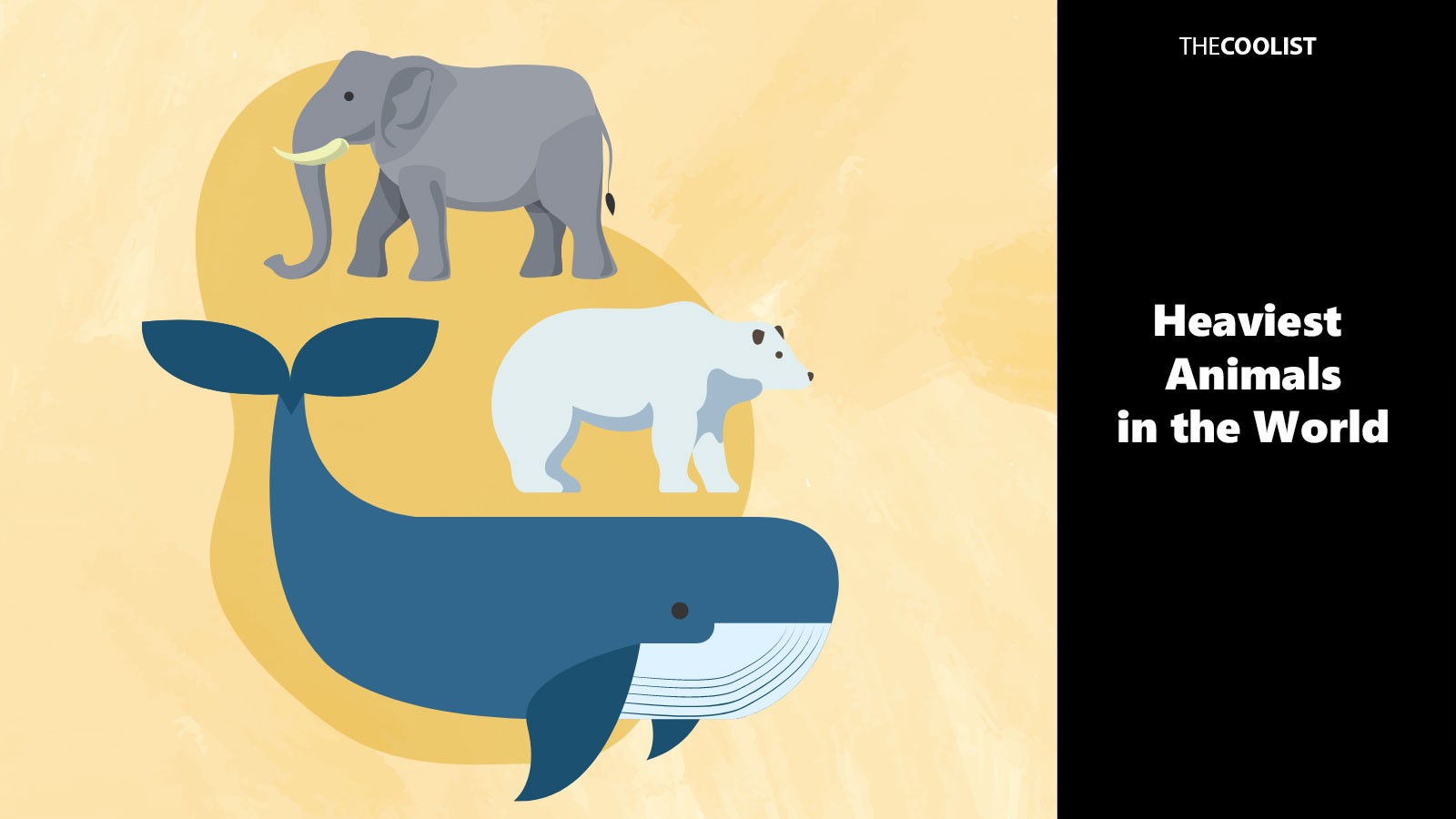
Below are the 10 heaviest animals in the world, ranked by weight in descending order.
- Blue whale: Reaches 200 tons (180,000 kg). Other whale species are the next heaviest animals in the world after the blue whale, with body weights ranging between 50-100 tons.
- Whale shark: Has a weight of up to 20.5 tons (18,700 kg)
- Elephant: Weighs up to 10.4 tons (9,500 kg). The African bush elephant is the heaviest species, while the Asian elephant is the least heavy in the family.
- Elephant seal: Reaches a weight of 4 tons (3,600 kg).
- Rhinoceros: Has a maximum weight of 0.93-4.4 tons (850-4,000 kg), depending on the species. White rhinos are the heaviest.
- Hippopotamus: Weigh as much as 4 tons (3,600 kg).
- Bovini: The heaviest species (gaurs) weigh up to 3,000 lb (1,360kg).
- Giraffe: Grows to a weight of 2,600 pounds (1,180 kg).
- Polar bear: Reach a weight of 2,200 lbs (1,000 kg).
- Saltwater crocodile: Has a maximum weight of 2,200 lbs (1,000 kg).
The ten hefty animals above are considered keystone species in their environments, meaning that they are instrumental to their local ecosystems. Due to their feeding patterns, the world’s heaviest animals act as landscape architects and shape the surrounding flora and fauna. These animals’ presence promotes biodiversity and ensures a biological balance in their ecosystems.
Below, we take a more in-depth look at each of the world’s 10 heaviest animals, their behavior, habitat, environmental impact, and human interaction.
1. Blue whale
The blue whale (Balaenoptera musculus) is a marine mammal of the baleen whale suborder Mysticeti and is the heaviest (and largest) animal in the world. Its maximum recorded weight of 200 tons (180,000 kg) makes the blue whale heavier than any dinosaur, or any other terrestrial or marine creature that ever existed on this planet.
View in gallery
Blue whales have long, slender bodies that reach lengths of 100 feet (30 meters). Their skin has a distinct mottled pattern and may be various shades of bluish-gray dorsally and somewhat lighter underneath. These whales have massive tail flukes, and a blowhole positioned on the top of their head. The latter expels a column of water and air several meters into the air when the animals surface from the depths to take a breath.
Habitat and feeding patterns
Blue whales live in deep offshore waters of all the world’s oceans except the Arctic, with a distribution that spans from the equator to the ice edges in polar regions. The reason behind blue whales’ vast global distribution is their lengthy migration pattern. Blue whales migrate annually between the warmer waters of the tropics, where they breed, to their feeding grounds in the colder regions.
The diet of a blue whale consists almost exclusively of krill, which are tiny, shrimp-like creatures. Blue whales consume enormous quantities of krill – up to 4 tons (3,600 kilograms) daily. They feed by taking in large volumes of water with krill in it, then pushing the water out through their baleen plates. The plates then trap the krill inside.
Blue whales’ feeding behavior helps support the health of marine environments by regulating krill populations. This regulation helps maintain balance in the ocean’s ecosystems.
Blue whales themselves have no predators apart from orcas (killer whales), who pose an occasional threat to young and sick individuals. Blue whales’ size places them at the top of their ecological niche, so they have no direct competition for their food sources – except among themselves.
Social behavior
Blue whales usually lead a solitary life but may travel in small groups (known as “pods”). To communicate with each other, blue whales vocalize. Their vocalizations are the loudest sounds produced by any animal on earth, and their sound waves travel long distances underwater. Marine biologists believe that the more complex blue whale songs are used for mate selection.
The reproductive cycle of blue whales is slow. Females give birth to a single calf every 2-3 years after a gestation period of about 11 months. Calves are born at a size of roughly 23 feet (7 meters) in length, and weigh approximately 2.5 tons (2,270 kilograms). After birth, the calves grow rapidly on the mother’s nutrient-rich milk and reach their adult weight and size by 15 years of age. Blue whales can live as long as 80-100 years if their lives are not cut short by environmental and human-made hazards.
Human interaction
The whaling industry hunted blue whales to the brink of extinction in the early 20th century, and these whales are now considered an endangered species. Blue whales are now protected by environmental regulation, and their populations are slowly recovering. That said, these majestic giants still face threats from ship strikes, entanglement in fishing gear, and the impacts of climate change on their cold-water habitat.
Other heavy whale species
Blue whales are the heaviest of all marine and terrestrial creatures, but other whale species follow closely behind in terms of body weight. The six whale species below are the next heaviest creatures on the planet after the blue whale.
- North Pacific Right Whale (Eubalaena japonica): up to 100 tons (about 90,000 kilograms)
- Bowhead Whale (Balaena mysticetus): over 100 tons (about 90,000 kilograms)
- North Atlantic Right Whale (Eubalaena glacialis): up to 80 tons (about 72,000 kilograms).
- Southern Right Whale (Eubalaena australis): 80 tons (about 72,000 kilograms).
- Fin whale (Balaenoptera physalus): up to 74 tons ( 67,000 kilograms)
- Sperm whale (Physeter macrocephalus): up to 57 tons (about 51,700 kilograms)
2. Whale shark
The whale shark (Rhincodon typus) is the second-heaviest animal after the largest whale species and the heaviest living fish in the world. Whale sharks weigh 20.5 tons (18,700 kilograms) on average.
View in gallery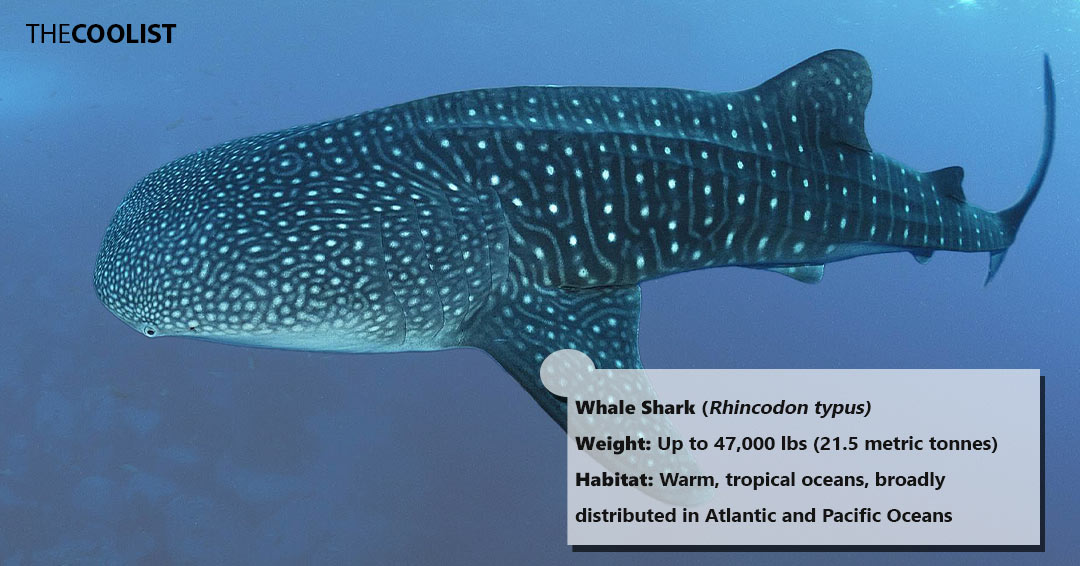
Whale sharks grow up to 60 feet (about 18 meters) in length, and their entire body is adorned with a pattern of white spots and stripes, which are unique to each individual. These sharks have a broad, flat head with a wide mouth at the front, and large gill slits with filter pads to sift plankton from the water.
Feeding behavior and habitat
Plankton is the primary diet of whale sharks, but these sharks likewise eat tiny plants and animals, small fish, and squid. They feed by swimming with their mouths open and filtering these small organisms through their gill slits. This filter-feeding method is beneficial for the ecosystem, as the sharks’ consumption of vast amounts of plankton helps maintain the balance of marine life at the lower levels of the food chain.
Whale sharks prefer warmer waters, especially near the surface in coastal and offshore areas with lots of plankton. These sharks are highly migratory but do not gravitate toward any given region. Instead, they traverse the world’s tropical and warm-temperate seas where food is abundant.
Social behavior
Whale sharks are solitary animals but are known to gather in large numbers in feeding grounds. Despite their size, they are gentle and are known to allow swimmers to hitch a ride (although this is discouraged for the sake of the animals’ well-being).
Adult whale sharks have no natural predators except for humans. Young whale sharks (known as “pups”), however, often fall prey to larger fish and carnivorous sharks.
Little is known about the reproduction of whale sharks. They are ovoviviparous, which means that the females produce eggs that hatch inside the body, and then give birth to live young pups. According to observations, whale sharks may give birth to hundreds of tiny pups at a time.
Human interaction
Whale sharks are a protected species under international law, but they are still threatened by human activities such as accidental catches in fishing gear, collisions with boats, and irresponsible tourism. Conservation authorities worldwide lead efforts to protect their habitats, understand their migration patterns, and ensure their sustainable interactions with humans.
3. Elephant
The elephant is a terrestrial mammal of the Elephantidae family, the third heaviest animal in the world, and the heaviest land animal alive today. The elephant family comprises the following three distinct species, ranked by weight:
- African bush elephant (Loxodonta africana): 10.4 tons (about 9,500 kg)
- African forest elephant (Loxodonta cyclotis): 6 tons (5,400 kg)
- Asian elephant (Elephas maximus): 4.4 tons (4,000 kg)
View in gallery
Elephants measure between 18 to 24 feet (5.5 to 7.3 meters) in length and reach heights of 8-13 feet (2.4-4 meters). They have thick, wrinkled skin that varies in shade between light gray and almost black.
Moreover, elephants have three distinguishing physical features: ears, trunks, and tusks. Elephants’ large ears help regulate body temperature. When elephants flap their ears, the blood flowing through the ears’ veins cools down before circulating back to the body. Additionally, elephants use their ears to detect and interpret sounds and to communicate with one another. The ears are especially pronounced in African elephants. Meanwhile, elephants’ long, muscular trunks serve as both an arm and a nose. They use their trunks to graze, drink water, communicate, and for bathing. Finally, elephants use their tusks to dig, break branches while foraging, strip bark from trees to use as food, and defend themselves from environmental hazards.
Habitat and feeding behavior
Elephants inhabit diverse environments that range from jungles to savannas in the world’s tropical regions. African bush elephants live in the savannas and grasslands of sub-Saharan Africa, while the forest elephants make the dense rainforests of Central and West Africa their home. Meanwhile, Asian elephants live in the grasslands and forests of South and Southeast Asia. Elephants in both Asia and Africa usually migrate over short distances within their habitat in search of food.
Elephants are herbivores with a diet consisting of leaves, bark, fruit, and a wide variety of vegetation. They consume up to 300 pounds (about 136 kilograms) of food per day, so they spend a significant portion of their time feeding.
Elephants’ feeding behavior transforms landscapes since it creates clearings in forests and allows new plants to grow. The newly grown vegetation, in turn, provides a habitat for other animal species. Moreover, elephant dung is important for seed dispersal, which supports the health and diversity of surrounding ecosystems.
Due to their massive size, adult elephants have no natural predators. However, elephant calves are vulnerable to attacks from lions, tigers, and hyenas. Elephants usually work together to repel such attacks and protect their young.
Social behavior
Elephants are highly social animals that live in complex matriarchal societies. Older, experienced females usually lead herds of other females and their young. Meanwhile, adult males either live on their own or form bachelor groups. That said, these males seek out female herds during the mating season, when they use their sense of smell to detect females in estrus.
Elephant reproduction comes with a lengthy gestation period. Gestation takes almost 22 months for African elephants and 18-22 months for Asian elephants – the longest time of any land animal. Females usually give birth to one calf, which stays dependent on the mother for several years.
Human interaction
Over millennia, people have used these animals in warfare, as beasts of burden, and as attractions in circuses and zoos. Today, elephants face significant threats from habitat destruction and poaching for their ivory tusks, and both activities are leading to a decline in their populations. There are ongoing conservation efforts to protect elephants and their habitats. These protection measures focus on anti-poaching, habitat restoration, and human-elephant conflict mitigation.
4. Elephant seal
Elephant seals are marine mammals of the genus Mirounga and are the fourth heaviest animal on the planet. There are two distinct species: the Northern elephant seal (Mirounga angustirostris) and the Southern elephant seal (Mirounga leonina). The Southern elephant seal holds the title for the largest of the two species, with males reaching weights of up to 4 tons (about 3,600 kilograms) and lengths of up to 20 feet (about 6 meters). Northern elephant seals are slightly smaller, with males weighing up to 2.3 tons (about 2,100 kilograms) and spanning as much as 14 feet (about 4.3 meters) in length.
View in gallery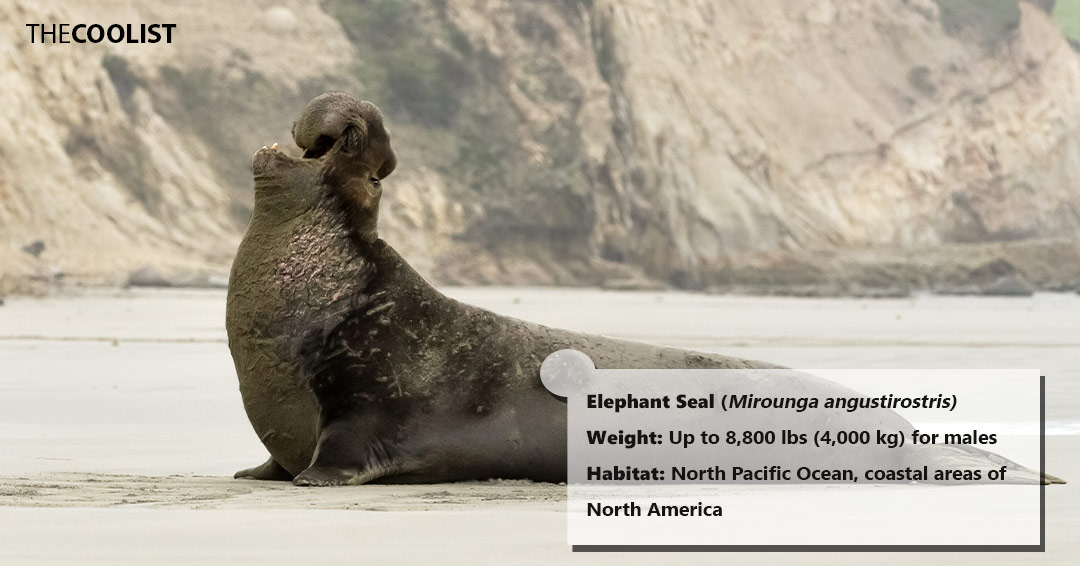
Elephant seals get their name from the distinctive large proboscis mature males have, which resembles an elephant’s trunk. Meanwhile, their robust, torpedo-shaped bodies are adapted for an aquatic lifestyle, with small flippers to help them swim and large, round eyes for better vision in low-light underwater conditions.
Feeding behavior and habitat
Elephant seals are deep-sea foragers. They feed on prey such as squid, fish, and sharks and are known for their ability to dive deep, often more than 3,280 feet (1,000 meters), to hunt for food. Once submerged, these seals can hunt for up to two hours underwater before resurfacing to breathe. Their deep-diving foraging behavior impacts the distribution and populations of deep-sea prey species and helps balance oceanic food webs.
At sea, elephant seals are themselves prey for natural predators such as orcas and large sharks. However, they are relatively safe from predators on land, since their large size deters most aggressors.
Elephant seals’ diet of fish and squid drives them to rich, deep oceanic feeding grounds, so their habitat is usually close to cold waters with abundant prey. Northern and Southern elephant seals inhabit cold marine environments in two different regions, as their names suggest. Northern elephant seals live in the North Pacific, where their habitat ranges from Baja California in Mexico to the Aleutian Islands in Alaska. On the other hand, Southern elephant seals live in the cold waters of the Southern Ocean, where they breed on sub-Antarctic islands. However, some populations venture as far north as the coasts of Brazil and South Africa. Elephant seals spend up to 90% of their time in the ocean and only come ashore to molt, breed, and give birth.
Reproduction and social behavior
The elephant seal breeding season starts with males arriving on beaches to establish territories and harems. Intense battles for dominance follow between males. In these contests, the male seals make loud roaring sounds with their proboscises and attack each other, often leaving the ring with significant injuries. The successful males mate with multiple females, who give birth to a single pup after a gestation period of about 11 months. The elephant seal mothers nurse their pups for approximately four weeks before weaning.
Human interaction
In the past, elephant seals were hunted to the brink of extinction for their blubber, which is used in oil production. However, recent conservation efforts and legal protections have helped their populations stabilize and even rebound.
5. Rhinoceros
The rhinoceros (commonly known as “rhino”) is a hoofed animal within the family Rhinocerotidae. The rhino is the 5th heaviest animal in the world, and the second heaviest terrestrial animal, after the elephant.
View in gallery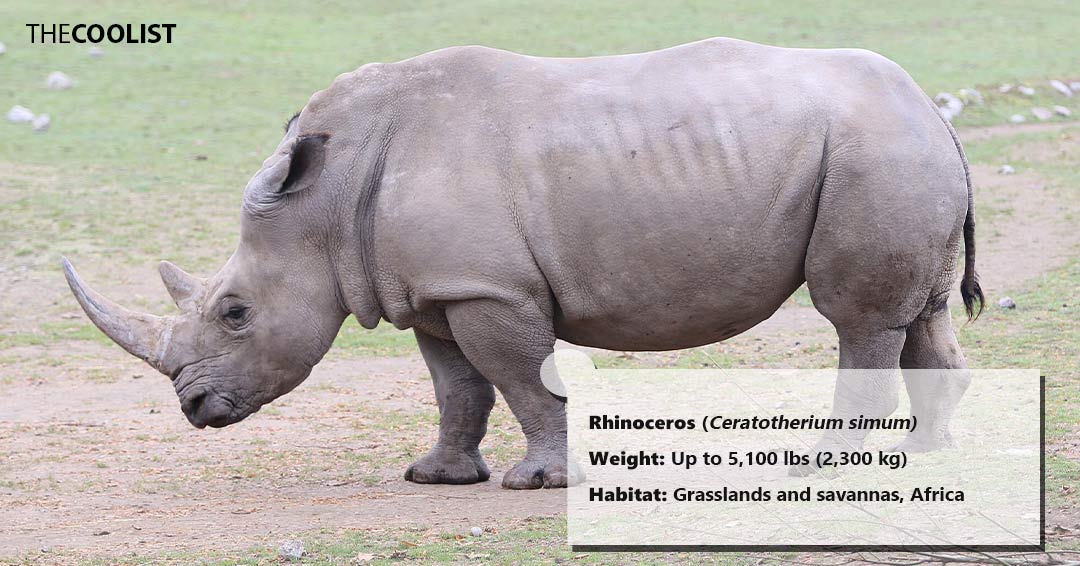
Below are the five extant rhino species, ranked by weight.
- White rhinoceros (Ceratotherium simum): up to 4.4 tons (4,000 kg)
- Javan rhinoceros (Rhinoceros sondaicus): up to 2.54 tons (2,300 kg)
- Indian rhinoceros (Rhinoceros unicornis): up to 2.43 tons (2,200 kg)
- Black rhinoceros (Diceros bicornis): up to 1.54 tons (1,400 kg)
- Sumatran rhinoceros (Dicerorhinus sumatrensis): 0.93 tons (850 kg)
Rhinos’ most distinctive feature is their one or two horns that grow from the snout. Moreover, these animals can be recognized by their broad chests, massive bodies, short legs, and large heads. The exact shape, color, and size of the bodies differ somewhat between the five rhino species, all of which inhabit different regions.
Habitat and feeding patterns
Rhinoceroses live in the savannas, grasslands, and dense forests in Africa and Asia. Their habitats are often determined by the proximity to bodies of water and adequate vegetation for grazing.
Rhinos are herbivorous, but their diets vary slightly among species. The white rhino primarily eats grass, while the black, Indian, Javan, and Sumatran rhinos prefer to feed on a mix of leaves, shoots, and branches. Their feeding behavior supports the surrounding ecosystem, as grazing and trampling help disperse seeds and create habitats for other animal species.
It’s not common for adult rhinos to fall prey to natural predators due to their size, the protective armor of their skin, and the menacing incisors and horns. However, lions, tigers (in Asia), and hyenas often hunt for young rhinos. Rhino mothers normally defend their calves from aggressors.
Social behavior
Most rhino species are solitary animals. White rhinos are the only species that form herds, while others prefer to live on their own or form mother-offspring pairs.
Rhino mothers have a gestation period of about 15-16 months, with the white rhino carrying the fetus the longest. Typically, rhinos give birth to a single calf, which then stays with its mother for 2-4 years.
Human interaction
Rhinos are critically endangered because of poaching. Humans hunt rhinos for their horns, which have a high demand in some East Asian countries, where they’re believed to have medicinal properties and are seen as a status symbol. Current conservation efforts like strict anti-poaching measures, habitat restoration, and breeding programs seem to be working, as rhino populations have been rising slowly.
6. Hippopotamus
The hippopotamus (Hippopotamus amphibius), is a herbivorous semi-aquatic mammal native to sub-Saharan Africa. The hippopotamus (colloquially known as “the hippo”) is the 6th heaviest animal in the world, and the third heaviest land animal after elephants and some rhino species. Adult hippos weigh as much as 4 tons (about 3,600 kilograms), measure up to 16.5 feet (about 5 meters) in length, and stand up to 5.2 feet (about 1.6 meters) tall at the shoulder.
View in gallery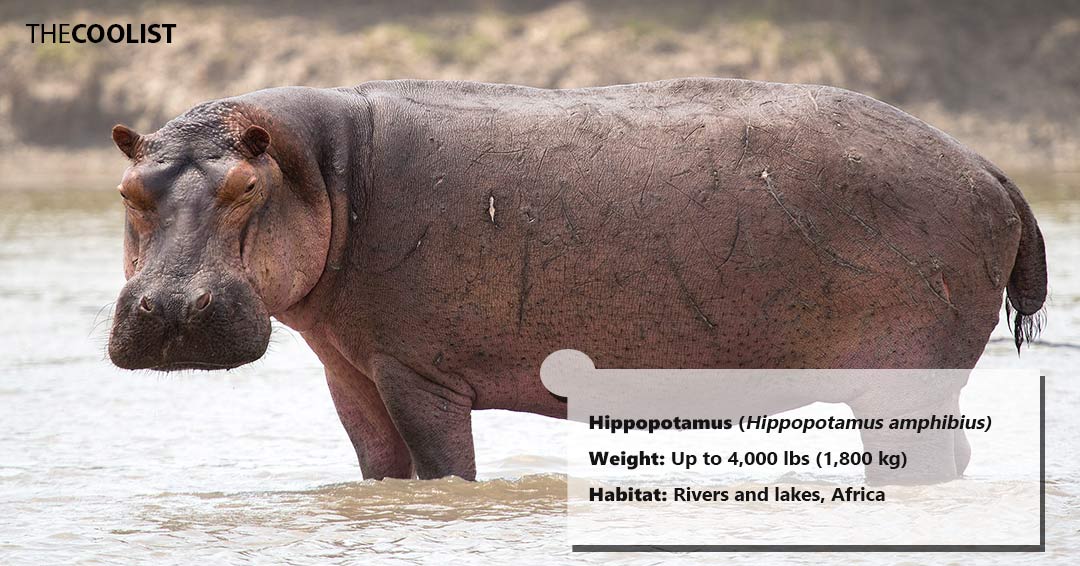
Hippos are easily recognizable by their wide mouths, barrel-shaped bodies, nearly hairless skin, and eyes and ears that are positioned at the top of their head. The eyes’ and ears’ position at the top of the head lets hippos breathe and observe their environment while staying mostly submerged. Meanwhile, their wide mouths house long, 20-inch (50 cm) canine tusks, which are primarily used for self-defense.
Habitat and feeding behavior
Hippos live partly on land and partly on water. They spend the day submerged in rivers, lakes, and mangrove swamps to keep cool under the African sun and come ashore at dusk to feed.
Despite their massive tusks, hippos are primarily herbivorous. At night, they venture onto land to graze and eat up to 150 pounds (about 68 kilograms) of grass before returning to water around dawn.
Hippos support their ecosystems by controlling vegetation growth along riverbanks and dispersing seeds through their feces. Their movement in and out of lakes and ponds helps aerate and mix the water, which in turn stimulates metabolism in the ecosystem.
Social behavior
Hippos are social animals and live in groups called “pods.” Each hippopotamus pod contains up to 30 individuals – mainly females and their young. Males are territorial within their water-bound areas and become extremely aggressive when other hippos, animals, or humans provoke them or encroach on their territory.
Adult hippos seldom fall prey to predatory animals due to their size and aggressive nature. However, young hippo calves may be whisked away and eaten by large predators such as lions, hyenas, and crocodiles.
Hippo females give birth to a single calf after an eight-month gestation period. The birth usually takes place in shallow water or on land near water. The mothers then nurse the calves for up to eight months, but the offspring may start grazing on grass as early as three weeks after birth.
Human interaction
Hippos are considered one of the most dangerous animals in Africa due to their aggressive nature and territoriality. Humans and hippos frequently come into conflict, especially in areas where human populations encroach on hippo habitats. Such encounters often lead to human fatalities. Conservation efforts are currently underway to protect hippo habitats and help manage the human-hippo conflict.
7. Bovini
The Bovini tribe is part of the Bovidae family and encompasses a diverse group of large bovids that include domestic cattle, bison, buffaloes, and the gaur (Bos gaurus). The gaur is the heaviest of the Bovini tribe and the eighth heaviest animal in the world, with an adult weight of about 1.5 tons (1,360kg). Their enormous weight stems from the animal’s gargantuan dimensions – fully grown individuals have a length of up to 10 feet (3.3 meters) and a height of up to 7.2 feet (2.2 meters) at the shoulder.
View in gallery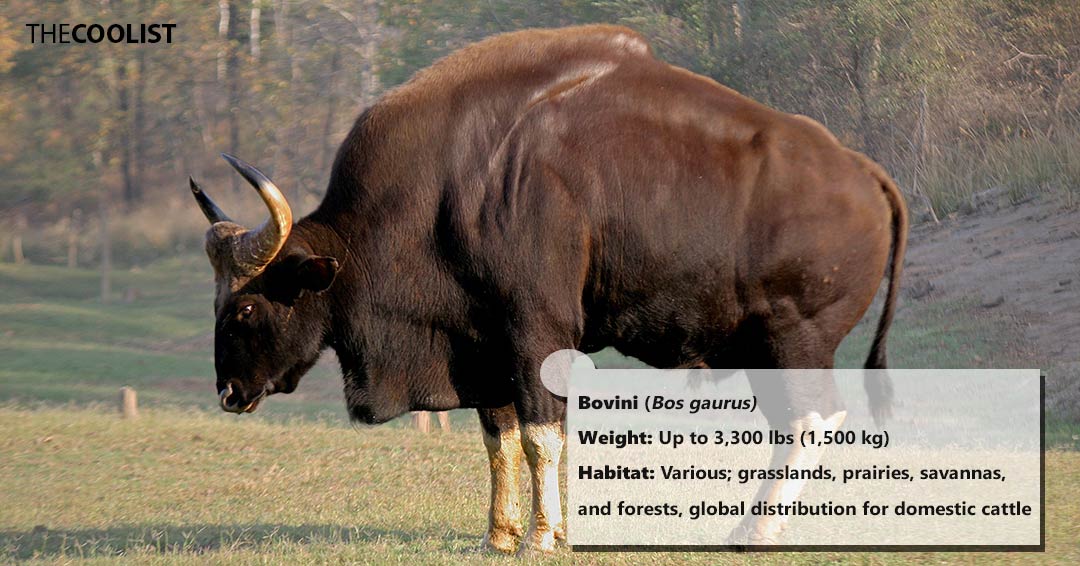
All bovini species share common characteristics such as strong, muscular bodies and a pair of horns. The gaur has a dark brown coat with distinctive white lower legs, a prominent dorsal ridge, a muscular neck, and strong, broad shoulders. This muscular frame helps the gaur push down saplings and bend branches as they graze leaves, fruit, and tender shoots from trees and shrubs.
Feeding behavior and habitat
Bovini diets are mainly made up of grasses, leaves, and shoots, which the animals consume in huge quantities. The gaur in particular requires a substantial amount of vegetation to sustain its energy needs. The animal often feeds during the cooler parts of the day and retreats to the cover of the forest to ruminate and rest. Through their grazing habits, gaurs shape the local vegetation and disperse seeds, which in turn supports the local ecosystems.
The Bovini tribe’s habitats vary depending on the species. For example, the North American plains are home to bison herds, whereas gaurs inhabit South and Southeast Asia. There, gaurs alternate between the dense cover of forests where they browse and open areas where they graze.
Bovini species are prey animals, but mainly when they are young or sick. For the gaur, natural predators include tigers and packs of dholes in Asia. However, adult gaurs are formidable opponents. Their impressive size, weight, and strength make them a lethal threat to predators who dare to attack them.
Social behavior
Social structures vary among Bovini. Gaurs are generally shy and typically form small herds led by an older female. In contrast, males live solitarily or in bachelor groups, and only join herds during the breeding season.
Reproductive strategies vary among Bovini. For example, bison form harems, and males end up mating with multiple females. In contrast, gaurs mate more spontaneously, usually when solitary males come across herds of females during the mating season. The gestation period for most bovine species is about 9 months, after which a single calf is usually born. Bovini calves are vulnerable in their early years but grow rapidly under the protection of the herd.
Human interaction
Historically, the interaction between humans and Bovini has revolved around domestication, as farmers and loggers tried to harness the animal’s power and use them as beasts of burden. That said, the US bison slaughter of the mid-19th century is a notably tragic chapter in this relationship between humans and Bovini. During the 1860s, an estimated 2 million bison were being killed annually – mostly as a way to starve and subjugate the indigenous populations. Since the 1860s, American bison populations have rebounded significantly. Meanwhile, the gaur continues to face threats from habitat loss, fragmentation, and poaching.
8. Giraffe
The giraffe (Giraffa camelopardalis) is the tallest living terrestrial animal, the largest ruminant on Earth, and the seventh heaviest species behind the hippopotamus. An adult giraffe weighs between 1,800 and 2,600 pounds (about 820 to 1,180 kilograms), and reaches heights of up to 18 feet (about 5.5 meters).
View in gallery
The giraffe’s most distinguishing features are its long neck and distinct coat pattern. A giraffe’s neck contains the same number of vertebrae as that of most other mammals, but each of its bones is greatly elongated. Meanwhile, the giraffe’s coat has a pattern of large, irregularly shaped patches of color separated by light lines. The pattern is unique to each individual. Additionally, giraffes have long legs and a prehensile tongue that’s up to 18 inches (45 cm) long, which helps them reach high branches for feeding together with their long neck.
Feeding patterns and habitat
Giraffes are browsers, so they feed primarily on the leaves, fruits, and flowers of woody plants. Of all the plants in their diet, giraffes prefer the acacia species. Their height allows them to access these trees’ foliage while it remains out of reach for other, shorter herbivores.
Giraffes’ browsing behavior supports their ecosystems by pollinating and dispersing seeds of the plants upon which they feed. Additionally, giraffe browsing shapes the vegetation structure and promotes biodiversity.
Giraffes are native to the savannas, grasslands, and open woodlands of sub-Saharan Africa, where their favorite acacia trees grow in abundance. They browse the trees in loose herds that may either include mother-offspring pairs or groups of bachelor males. Giraffes communicate among themselves within the herd through sounds and body language, especially when facing danger from predators. Otherwise, these animals have a quiet demeanor.
Giraffes are prey for predators such as lions, leopards, hyenas, and African wild dogs. Giraffe calves are especially vulnerable since they lack the strength and defense skills of older individuals. Mother giraffes guard their calves diligently, but predation is still a significant cause of calf mortality.
Reproduction
Giraffe females (known as cows) have a gestation period of about 15 months and normally give birth to a single calf. Calves stand and run within a few hours of birth, and this ability is crucial for survival in their predator-rich habitats.
Human interaction
Today, giraffes face habitat loss due to agricultural expansion and human settlement, poaching for their hide, meat, and tail, and civil unrest in some parts of Africa. Conservation efforts include habitat protection, anti-poaching patrols, and research to better understand giraffe behavior and ecology.
9. Polar bear
Polar bears (Ursus maritimus) are the heaviest land carnivores, with adult males reaching as much as 2,200 lbs (1,000 kg). They measure over 8 feet (about 2.4 meters) in length, which also makes them the largest extant bear species.
View in gallery
Polar bears’ most distinguishing feature is their white or creamy yellow fur, which serves as camouflage in their arctic surroundings. These bears have a long, streamlined body, a powerful build, and a large skull with strong jaws. Their paws are wide and covered in thick fur, which insulates them and gives them traction on ice. Moreover, the paws are slightly webbed to aid polar bears’ swimming abilities in the Arctic waters.
Habitat and feeding pattern
The primary habitat of polar bears is the sea ice of the Arctic Ocean, from Canada and Greenland to Norway’s Svalbard archipelago and the northern coasts of Russia and Alaska. In their habitat, polar bears rely on the ice to hunt their primary source of nutrition: seals.
Polar bears are apex predators with a diet made up of ringed and bearded seals. They use the sea ice as a platform to hunt seals, either by waiting at seal breathing holes or breaking into their dens. As top predators, they help regulate seal populations, which in turn influences the fish populations and overall health of the marine environment.
Adult polar bears have no natural enemies, as they sit atop the Arctic food chain. However, their cubs are vulnerable to other predators, including wolves and other polar bears.
Social behavior
Polar bears are solitary animals, except for females who are nursing their cubs or brief mating encounters during the breeding season. Polar bears’ gestation includes a period of delayed implantation, and the total gestation lasts about 8 months. Females give birth to 1-3 cubs in snow dens during the winter and emerge in the spring. Cubs stay with their mother for over two years as they learn essential survival skills.
Human interaction
Humans are an indirect threat to polar bears since human activities contribute to climate change and the latter deeply affects polar bear habitats. The warming climate is gradually reducing the extent and thickness of sea ice, on which polar bears rely for hunting and breeding. Additionally, polar bears face habitat risks associated with pollution, shipping, and resource extraction. In recent years, conflicts between humans and polar bears have increased, as the bears get displaced by melting ice and end up seeking food closer to human settlements.
10. Saltwater crocodile
The saltwater crocodile (Crocodylus porosus) is an aquatic predator and the heaviest living reptile in the world, with adults weighing as much as 2,200 pounds (about 1,000 kg). These gigantic crocodiles grow up to 20 feet (6 meters) in length – a size that eclipses other crocodile species.
View in gallery
Saltwater crocodiles have a broad body, powerful tail, a V-shaped snout, and massive jaws that house conical teeth designed for gripping and tearing their prey. Their skin is scaly and ranges in color from dark green to brown. It serves as both armor and camouflage that helps the crocodiles blend into their environment.
Habitat and feeding behavior
The saltwater crocodile’s habitat ranges from brackish mangrove swamps and estuaries to freshwater rivers and even open ocean environments in Southeast Asia, Northern Australia, and nearby regions.
Saltwater crocodiles are apex predators with a broad diet that includes fish, birds, mammals, and other reptiles. To hunt, saltwater crocodiles use their characteristic “sit-and-wait” hunting strategy, where they remain motionless for long periods before launching a swift and powerful attack on unsuspecting prey.
Social behavior
Saltwater crocodiles are solitary and territorial animals. Male individuals in particular often exhibit aggressive behavior to defend their territories. Meanwhile, the females fiercely protect their young from encroaching predators.
The females lay eggs in nests made of vegetation and mud, usually on riverbanks. The temperature during incubation determines the sex of the offspring. Females guard their nests vigilantly until the eggs hatch, then help the young reach the water.
Human interaction
Human encounters with saltwater crocodiles have increased due to habitat encroachment. Crocodile attacks on humans are rare but often fatal. Current conservation efforts focus on mitigating the risk of crocodile-human conflict, as well as habitat protection and population monitoring. At the time of writing, there is no perceived threat to saltwater crocodile populations, although they have been hunted to extinction in some regions, like Vietnam.
What is the importance of the environment for heavy animals?
The environment is important for heavy animals because it provides food, water, and a suitable habitat for breeding and shelter. Heavy animals require large amounts of food and water daily, and only resource-rich and diverse environments can sustain these needs. Additionally, these animals’ large size necessitates extensive habitats for movement and migration.
But, what is the most important heaviest animal? Each of the world’s heaviest animals is important within its own ecosystem. For example, blue whales help keep krill populations under control in the world’s oceans. Meanwhile, elephants help promote biodiversity by trampling vegetation and making room for other species, and dispersing seeds with their feces.
Why are heavy animals important in the environment?
Heavy animals are important in the environment because they shape their ecosystems. For example, heavy animals like elephants and bison change the local vegetation landscape through their feeding habits, dig water holes that other species use, and disperse seeds. In turn, these behaviors promote the health and diversity of their habitats.
How does the behavior of the heaviest animals affect other animals?
The behavior of the heaviest animals affects other animals by altering habitats and influencing food chains. For example, elephants transform landscapes by knocking down trees. This behavior creates clearings in local vegetation that promote new growth beneficial to other species. Meanwhile, whales support the cycling of nutrients in oceans by eating a krill-rich diet. This behavior supports marine life at multiple levels of the food chain.
What are the largest animals in the world?
The following are the five largest animals (relative to the rest of their type) in the world.
- Blue whale: The blue whale is the largest animal in the world. It reaches lengths of up to 100 feet (30 meters) and weighs up to 200 tons (approximately 181 metric tons).
- Ostrich: The ostrich is the world’s largest bird. It stands up to 9 feet (2.7 meters) tall and weighs up to 320 pounds (145 kilograms).
- Komodo dragon: The Komodo dragon is the largest living lizard. It grows to a length of 10 feet (3 meters) and weighs approximately 150 pounds (68 kilograms).
- Whale shark: The whale shark is the largest fish in the world. It grows up to 60 feet (18 meters) long and weighs as much as 21.5 tons (about 19.5 metric tons).
- Giraffe: The giraffe is the tallest land animal. It reaches heights of up to 18 feet (5.5 meters) and weighs up to 2,800 pounds (1,270 kilograms).
What are the smallest animals in the world?
Below are the five smallest animals (relative to the rest of their type) in the world.
- Bee hummingbird: The bee hummingbird is the smallest bird in the world. It measures 2.4 inches (6 centimeters) in length and weighs 0.07 ounces (2 grams).
- Etruscan shrew: The Etruscan shrew is one of the smallest mammals. It has a body length of about 1.5 inches (3.8 centimeters) and weighs around 0.06 ounces (1.8 grams).
- Kitti’s hog-nosed bat: Kitti’s hog-nosed bat is the smallest bat in the world. It grows to 1.1 inches (2.8 centimeters) in length and weighs 0.07 ounces (2 grams).
- Paedophryne amanuensis: Paedophryne amanuensis holds the title of the world’s smallest frog and the smallest vertebrate. It has a length of only 0.3 inches (7.7 millimeters).
- Slender blind snakes: Slender blind snakes are among the world’s smallest snakes. Some species measure as little as 4 inches (10 centimeters) in length.
What are the friendliest animals in the world?
The six friendliest animals to humans in the world are as follows.
- Dogs: Dogs have earned the nickname “man’s best friend” due to their symbiotic relationship with humanity. Dogs are highly expressive, highly social animals that display a complex range of emotions and behaviors that endear them to humans.
- Cats: Cats are one of the friendliest animals due to their affectionate behavior, which includes purring, kneading, and nuzzling. Cats use this behavior to express comfort and contentment with their human companions.
- Dolphins: Dolphins are intelligent and have a playful nature. They approach humans with curiosity and engage them, which makes them one of the friendliest marine animals.
- Horses: Horses have a gentle demeanor, form strong bonds with humans, and are responsive to human emotions and commands.
- Rabbits: Rabbits are considered friendly due to their social nature. They seek out human interaction and show affection through nudging, hopping, and cuddling with their owners.
- Guinea pigs: Guinea pigs have a docile and friendly temperament. They express affection for humans through vocalizations and gentle nibbling and enjoy being held and petted.

